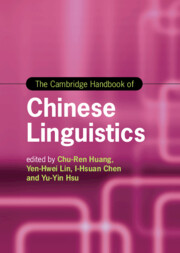Book contents
- The Cambridge Handbook of Chinese Linguistics
- Cambridge Handbooks In Language and Linguistics
- The Cambridge Handbook of Chinese Linguistics
- Copyright page
- Contents
- Figures
- Tables
- Contributors
- Acknowledgments
- Part One Writing System/Neuro-cognitive Processing of Chinese
- Part Two Morpho-lexical Issues in Chinese
- Part Three Phonetic-phonological Issues in Chinese
- Part Four Syntax-semantics, Pragmatics, and Discourse Issues
- 19 SVO as the Canonical Word Order in Modern Chinese
- 20 SOV as the Canonical Word Order in Modern Chinese
- 21 Semantic and Pragmatic Conditions on Word Order Variation in Chinese
- 22 The Case for Case in Chinese
- 23 The Case without Case in Chinese
- 24 The Syntax of Classifiers in Mandarin Chinese
- 25 The Chinese Classifier System as a Lexical-semantic System
- 26 Syntax of Sentence-final Particles in Chinese
- 27 Sentence-final Particles
- 28 Topicalization Defined by Syntax
- 29 An Interactive Perspective on Topic Constructions in Mandarin
- 30 Grammatical Acceptability in Mandarin Chinese
- Index
- References
30 - Grammatical Acceptability in Mandarin Chinese
from Part Four - Syntax-semantics, Pragmatics, and Discourse Issues
Published online by Cambridge University Press: 04 August 2022
- The Cambridge Handbook of Chinese Linguistics
- Cambridge Handbooks In Language and Linguistics
- The Cambridge Handbook of Chinese Linguistics
- Copyright page
- Contents
- Figures
- Tables
- Contributors
- Acknowledgments
- Part One Writing System/Neuro-cognitive Processing of Chinese
- Part Two Morpho-lexical Issues in Chinese
- Part Three Phonetic-phonological Issues in Chinese
- Part Four Syntax-semantics, Pragmatics, and Discourse Issues
- 19 SVO as the Canonical Word Order in Modern Chinese
- 20 SOV as the Canonical Word Order in Modern Chinese
- 21 Semantic and Pragmatic Conditions on Word Order Variation in Chinese
- 22 The Case for Case in Chinese
- 23 The Case without Case in Chinese
- 24 The Syntax of Classifiers in Mandarin Chinese
- 25 The Chinese Classifier System as a Lexical-semantic System
- 26 Syntax of Sentence-final Particles in Chinese
- 27 Sentence-final Particles
- 28 Topicalization Defined by Syntax
- 29 An Interactive Perspective on Topic Constructions in Mandarin
- 30 Grammatical Acceptability in Mandarin Chinese
- Index
- References
Summary
In this chapter, we address the issues related to sentence grammaticality and acceptability. We begin with a discussion of the relationship between the two notions, and point out that despite the differences in theoretical conceptualization, the two notions, grammaticality and acceptability, are often confluent and that grammaticality is usually measured as acceptability in linguistic research. We then discuss factors beyond syntax that may influence sentence acceptability, including processing factors and semantic/pragmatic considerations. Finally, we discuss the measurement of acceptability, via either experimental methods or corpus-based analyses. To conclude, we show in this chapter how grammaticality, a seemingly purely syntactic notion, is often materialized as acceptability, which encompasses multiple linguistic modules that go beyond syntax.
- Type
- Chapter
- Information
- The Cambridge Handbook of Chinese Linguistics , pp. 669 - 706Publisher: Cambridge University PressPrint publication year: 2022



